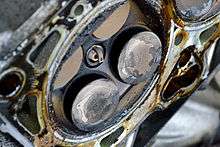Interference engine
An interference engine is a type of 4-stroke internal combustion piston engine in which one or more valves in the fully open position extends into any area that the piston may travel into. By contrast, in a non-interference engine the piston does not travel into any area into which the valves open. Interference engines rely on timing gears, chains, or belts to prevent the piston from striking the valves by ensuring that the valves are closed when the piston is near top dead center. Interference engines are prevalent among modern production automobiles and many other 4-stroke engine applications; the main advantage is that it allows engine designers to maximize the engine's compression ratio. However, such engines risk major internal damage if the piston strikes the valve(s) due to failure or poor maintenance of the timing components and/or camshaft(s).[1]
Timing gear failure

In interference engine designs, regular belt or chain service is especially important as incorrect timing may result in the pistons and valves colliding and causing extensive internal engine damage and therefore costly repairs. The piston will likely bend the valves, or if a piece of valve or piston is broken off within the cylinder, the broken piece may cause severe damage within the cylinder, possibly affecting the connecting rods.
